#typescript array
Explore tagged Tumblr posts
Video
youtube
TypeScript Tutorial on Array Tuples Special Types Any Unknown Null for J... Full Video Link - https://youtu.be/kIWYyQoDJU0 Check out this new video on the CodeOneDigest YouTube channel! Learn Array tuple in typescript & Special types like any unknown null undefined. Learn how to use tuple array & special types in typescript language. #video #typescript #array #tuple #any #unknown #null #undefined #nodejs #javascript #codeonedigest@java @awscloud @AWSCloudIndia @YouTube @codeonedigest #typescript #javascript #typescript #javascript #typescripttutorial #typescriptforbeginners #learntypescript #typescriptarraymap #tuplesintypescript #typescripttuples #typescriptanyvsunknown #typescriptcompletetutorial #typescriptcompleteplaylist #typescriptcompleteguide #typescriptjavascript #typescriptprogramminglanguage #typescriptfullcourse #typescripttutorialforbeginners #typescriptunknowntype #typescriptnull #typescriptundefined #typescriptundefinedvsnull #array
#youtube#typescript#typescript array#typescript development#typescript programming language#typescript types
1 note
·
View note
Text
React Hook Form Register Function: A Comprehensive Guide
Introduction React Hook Form is a popular open-source library for building forms in React applications. It provides a simple and declarative API for managing form state, validation, and submission. One of the core concepts in React Hook Form is the register function, which is used to register form fields and apply validation rules to them. In this article, we will take a deep dive into the…
View On WordPress
#form register react#react form register#react hook form register#react hook form register array#react hook form register custom component#react hook form register typescript#register in react hook form#register react hook form#register useform#useform register#useformregister#useformregisterreturn
0 notes
Text
Let's talk about filtering and mapping! 🤓
I'm working on the menu page for a restaurant, and as someone with very little frontend experience I wasn't sure how to go about parsing through a JSON file to return certain objects.
After some searching, procrastinating, going through this course, and then more searching - I finally came across the documentation I needed here!
So what is filtering and mapping? .filter() and .map() are JavaScript methods.
filter allows you to filter through an array of objects given some logic (want to find all the items with an id greater than 7? filter. Want to find all the items where the name is equal to "burger" that works too, want to add multiple conditions to find all the items with and id greater than 7 AND the name is "burger" well filter has got your back).
map is used to iterate through an array and call a function on every element in it. I used it to map each item to a list.
Here's an example: We have a JSON file of some food items.
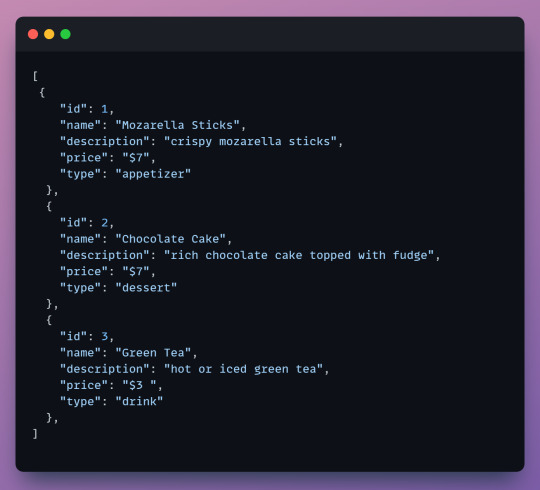
We want to grab all the desserts from our menu and display them on the desserts page of our website. It's time to filter!
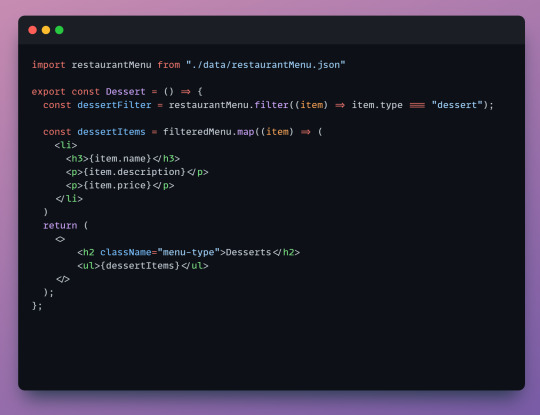
Keep in mind that the filter method returns a new array with all the objects that we want. In this case when we filter we will get an array with all the desserts.
First we import our JSON file so we can access it.
Next, we create a constant called dessertFilter which will hold our filtered array. dessertFilter will hold all items that have the type equal to dessert. In our example it will hold the chocolate cake object.
Next, we map each item from the new array to a list. This is the list that we'll see displayed on the page. You can choose which properties you want to map. We only map the name, description and price since there's no need for the user to see the item type or id.
Lastly, our return statement contains everything we will see on the page. In our return we have a header and the list of items - we wrap our list, dessertItems in an unordered list since list items need to be wrapped in either an ordered or unordered list.
Here's our result! We can style this with css later.

Cool! so we filtered for dessert but what about our other menu items? Time to make a reusable component.
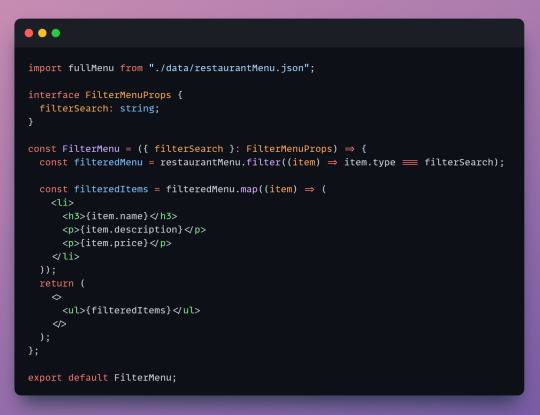
The code is almost the same, but to make this component reusable we create an interface. Interfaces define objects and specify their properties. We specify an object called filterSearch that will act as a placeholder - we set it as a string since the item "types" in our JSON file are strings. (I'm using typescript which accepts interfaces but i believe vanilla javascript does not).
Now lets see the component in action
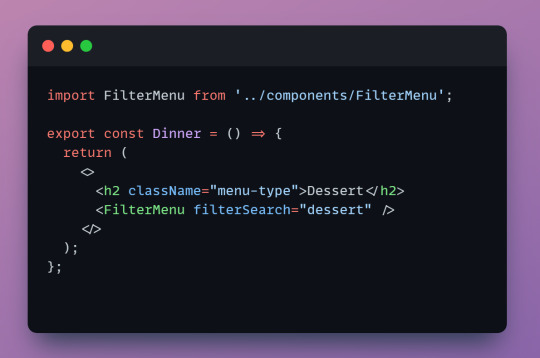
Import the component so we can call it.
When we call FilterMenu we have to include filterSearch from our interface. The component needs to know what we're looking for. Here we can set it to any valid type like "dessert", "drink", or "appetizer" and it will display them.
Woo! now we're filtering and mapping with one line of code! and we can reuse it for our other pages too.
Last thing, these methods are chainable! you can connect them and have the same logic in one constant.
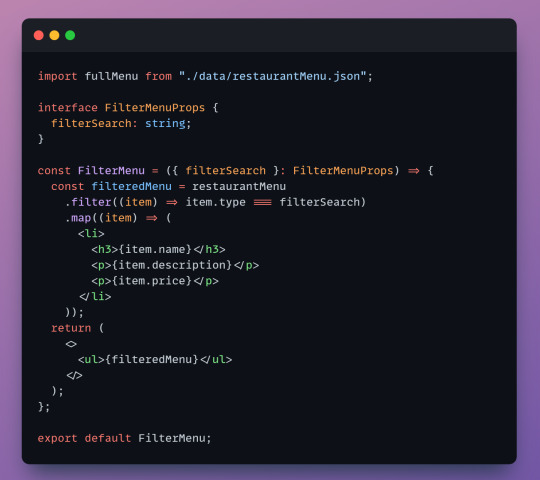
Before reading the documentation, I had seperate JSON files for each menu category and was reusing the same code to map each file on each individual menu page. It was a lot of duplicate code, not great. Now, I have a single JSON file and a reusable component. It's satisying how clean it is!
Learning on your own can be frustrating sometimes, it can be hard to search for solutions when you don't know where to begin. I had never heard of filtering or mapping before this. If you're ever stuck keep pushing! there's so many resources and communities out there.
p.s. I'm open to any suggestions!
10 notes
·
View notes
Text
Beautiful UI Components For Next.js Projects - Serenity UI
Serenity UI provides a set of ready-to-use UI components for your Next.js projects. It leverages TailwindCSS for styling, TypeScript for strong typing, and Framer Motion for animations. The library is open-source and free to use in both personal and commercial endeavors. It provides a wide array of beautiful UI components, including testimonials, pricing sections, authentication forms, carousels,…
2 notes
·
View notes
Text
This Week in Rust 510
Hello and welcome to another issue of This Week in Rust! Rust is a programming language empowering everyone to build reliable and efficient software. This is a weekly summary of its progress and community. Want something mentioned? Tag us at @ThisWeekInRust on Twitter or @ThisWeekinRust on mastodon.social, or send us a pull request. Want to get involved? We love contributions.
This Week in Rust is openly developed on GitHub and archives can be viewed at this-week-in-rust.org. If you find any errors in this week's issue, please submit a PR.
Updates from Rust Community
Official
Announcing Rust 1.72.0
Change in Guidance on Committing Lockfiles
Cargo changes how arrays in config are merged
Seeking help for initial Leadership Council initiatives
Leadership Council Membership Changes
Newsletters
This Week in Ars Militaris VIII
Project/Tooling Updates
rust-analyzer changelog #196
The First Stable Release of a Memory Safe sudo Implementation
We're open-sourcing the library that powers 1Password's ability to log in with a passkey
ratatui 0.23.0 is released! (official successor of tui-rs)
Zellij 0.38.0: session-manager, plugin infra, and no more offensive session names
Observations/Thoughts
The fastest WebSocket implementation
Rust Malware Staged on Crates.io
ESP32 Standard Library Embedded Rust: SPI with the MAX7219 LED Dot Matrix
A JVM in Rust part 5 - Executing instructions
Compiling Rust for .NET, using only tea and stubbornness!
Ad-hoc polymorphism erodes type-safety
How to speed up the Rust compiler in August 2023
This isn't the way to speed up Rust compile times
Rust Cryptography Should be Written in Rust
Dependency injection in Axum handlers. A quick tour
Best Rust Web Frameworks to Use in 2023
From tui-rs to Ratatui: 6 Months of Cooking Up Rust TUIs
[video] Rust 1.72.0
[video] Rust 1.72 Release Train
Rust Walkthroughs
[series] Distributed Tracing in Rust, Episode 3: tracing basics
Use Rust in shell scripts
A Simple CRUD API in Rust with Cloudflare Workers, Cloudflare KV, and the Rust Router
[video] base64 crate: code walkthrough
Miscellaneous
Interview with Rust and operating system Developer Andy Python
Leveraging Rust in our high-performance Java database
Rust error message to fix a typo
[video] The Builder Pattern and Typestate Programming - Stefan Baumgartner - Rust Linz January 2023
[video] CI with Rust and Gitlab Selfhosting - Stefan Schindler - Rust Linz July 2023
Crate of the Week
This week's crate is dprint, a fast code formatter that formats Markdown, TypeScript, JavaScript, JSON, TOML and many other types natively via Wasm plugins.
Thanks to Martin Geisler for the suggestion!
Please submit your suggestions and votes for next week!
Call for Participation
Always wanted to contribute to open-source projects but did not know where to start? Every week we highlight some tasks from the Rust community for you to pick and get started!
Some of these tasks may also have mentors available, visit the task page for more information.
Hyperswitch - add domain type for client secret
Hyperswitch - deserialization error exposes sensitive values in the logs
Hyperswitch - move redis key creation to a common module
mdbook-i18n-helpers - Write tool which can convert translated files back to PO
mdbook-i18n-helpers - Package a language selector
mdbook-i18n-helpers - Add links between translations
Comprehensive Rust - Link to correct line when editing a translation
Comprehensive Rust - Track the number of times the redirect pages are visited
RustQuant - Jacobian and Hessian matrices support.
RustQuant - improve Graphviz plotting of autodiff computational graphs.
RustQuant - bond pricing implementation.
RustQuant - implement cap/floor pricers.
RustQuant - Implement Asian option pricers.
RustQuant - Implement American option pricers.
release-plz - add ability to mark Gitea/GitHub release as draft
zerocopy - CI step "Set toolchain version" is flaky due to network timeouts
zerocopy - Implement traits for tuple types (and maybe other container types?)
zerocopy - Prevent panics statically
zerocopy - Add positive and negative trait impl tests for SIMD types
zerocopy - Inline many trait methods (in zerocopy and in derive-generated code)
datatest-stable - Fix quadratic performance with nextest
Ockam - Use a user-friendly name for the shared services to show it in the tray menu
Ockam - Rename the Port to Address and support such format
Ockam - Ockam CLI should gracefully handle invalid state when initializing
css-inline - Update cssparser & selectors
css-inline - Non-blocking stylesheet resolving
css-inline - Optionally remove all class attributes
If you are a Rust project owner and are looking for contributors, please submit tasks here.
Updates from the Rust Project
366 pull requests were merged in the last week
reassign sparc-unknown-none-elf to tier 3
wasi: round up the size for aligned_alloc
allow MaybeUninit in input and output of inline assembly
allow explicit #[repr(Rust)]
fix CFI: f32 and f64 are encoded incorrectly for cross-language CFI
add suggestion for some #[deprecated] items
add an (perma-)unstable option to disable vtable vptr
add comment to the push_trailing function
add note when matching on tuples/ADTs containing non-exhaustive types
add support for ptr::writes for the invalid_reference_casting lint
allow overwriting ExpnId for concurrent decoding
avoid duplicate large_assignments lints
contents of reachable statics is reachable
do not emit invalid suggestion in E0191 when spans overlap
do not forget to pass DWARF fragment information to LLVM
ensure that THIR unsafety check is done before stealing it
emit a proper diagnostic message for unstable lints passed from CLI
fix races conditions with SyntaxContext decoding
fix waiting on a query that panicked
improve note for the invalid_reference_casting lint
include compiler flags when you break rust;
load include_bytes! directly into an Lrc
make Sharded an enum and specialize it for the single thread case
make rustc_on_unimplemented std-agnostic for alloc::rc
more precisely detect cycle errors from type_of on opaque
point at type parameter that introduced unmet bound instead of full HIR node
record allocation spans inside force_allocation
suggest mutable borrow on read only for-loop that should be mutable
tweak output of to_pretty_impl_header involving only anon lifetimes
use the same DISubprogram for each instance of the same inlined function within a caller
walk through full path in point_at_path_if_possible
warn on elided lifetimes in associated constants (ELIDED_LIFETIMES_IN_ASSOCIATED_CONSTANT)
make RPITITs capture all in-scope lifetimes
add stable for Constant in smir
add generics_of to smir
add smir predicates_of
treat StatementKind::Coverage as completely opaque for SMIR purposes
do not convert copies of packed projections to moves
don't do intra-pass validation on MIR shims
MIR validation: reject in-place argument/return for packed fields
disable MIR SROA optimization by default
miri: automatically start and stop josh in rustc-pull/push
miri: fix some bad regex capture group references in test normalization
stop emitting non-power-of-two vectors in (non-portable-SIMD) codegen
resolve: stop creating NameBindings on every use, create them once per definition instead
fix a pthread_t handle leak
when terminating during unwinding, show the reason why
avoid triple-backtrace due to panic-during-cleanup
add additional float constants
add ability to spawn Windows process with Proc Thread Attributes | Take 2
fix implementation of Duration::checked_div
hashbrown: allow serializing HashMaps that use a custom allocator
hashbrown: change & to &mut where applicable
hashbrown: simplify Clone by removing redundant guards
regex-automata: fix incorrect use of Aho-Corasick's "standard" semantics
cargo: Very preliminary MSRV resolver support
cargo: Use a more compact relative-time format
cargo: Improve TOML parse errors
cargo: add support for target.'cfg(..)'.linker
cargo: config: merge lists in precedence order
cargo: create dedicated unstable flag for asymmetric-token
cargo: set MSRV for internal packages
cargo: improve deserialization errors of untagged enums
cargo: improve resolver version mismatch warning
cargo: stabilize --keep-going
cargo: support dependencies from registries for artifact dependencies, take 2
cargo: use AND search when having multiple terms
rustdoc: add unstable --no-html-source flag
rustdoc: rename typedef to type alias
rustdoc: use unicode-aware checks for redundant explicit link fastpath
clippy: new lint: implied_bounds_in_impls
clippy: new lint: reserve_after_initialization
clippy: arithmetic_side_effects: detect division by zero for Wrapping and Saturating
clippy: if_then_some_else_none: look into local initializers for early returns
clippy: iter_overeager_cloned: detect .cloned().all() and .cloned().any()
clippy: unnecessary_unwrap: lint on .as_ref().unwrap()
clippy: allow trait alias DefIds in implements_trait_with_env_from_iter
clippy: fix "derivable_impls: attributes are ignored"
clippy: fix tuple_array_conversions lint on nightly
clippy: skip float_cmp check if lhs is a custom type
rust-analyzer: diagnostics for 'while let' loop with label in condition
rust-analyzer: respect #[allow(unused_braces)]
Rust Compiler Performance Triage
A fairly quiet week, with improvements exceeding a small scattering of regressions. Memory usage and artifact size held fairly steady across the week, with no regressions or improvements.
Triage done by @simulacrum. Revision range: d4a881e..cedbe5c
2 Regressions, 3 Improvements, 2 Mixed; 0 of them in rollups 108 artifact comparisons made in total
Full report here
Approved RFCs
Changes to Rust follow the Rust RFC (request for comments) process. These are the RFCs that were approved for implementation this week:
Create a Testing sub-team
Final Comment Period
Every week, the team announces the 'final comment period' for RFCs and key PRs which are reaching a decision. Express your opinions now.
RFCs
No RFCs entered Final Comment Period this week.
Tracking Issues & PRs
[disposition: merge] Stabilize PATH option for --print KIND=PATH
[disposition: merge] Add alignment to the NPO guarantee
New and Updated RFCs
[new] Special-cased performance improvement for Iterator::sum on Range<u*> and RangeInclusive<u*>
[new] Cargo Check T-lang Policy
Call for Testing
An important step for RFC implementation is for people to experiment with the implementation and give feedback, especially before stabilization. The following RFCs would benefit from user testing before moving forward:
No RFCs issued a call for testing this week.
If you are a feature implementer and would like your RFC to appear on the above list, add the new call-for-testing label to your RFC along with a comment providing testing instructions and/or guidance on which aspect(s) of the feature need testing.
Upcoming Events
Rusty Events between 2023-08-30 - 2023-09-27 🦀
Virtual
2023-09-05 | Virtual (Buffalo, NY, US) | Buffalo Rust Meetup
Buffalo Rust User Group, First Tuesdays
2023-09-05 | Virtual (Munich, DE) | Rust Munich
Rust Munich 2023 / 4 - hybrid
2023-09-06 | Virtual (Indianapolis, IN, US) | Indy Rust
Indy.rs - with Social Distancing
2023-09-12 - 2023-09-15 | Virtual (Albuquerque, NM, US) | RustConf
RustConf 2023
2023-09-12 | Virtual (Dallas, TX, US) | Dallas Rust
Second Tuesday
2023-09-13 | Virtual (Boulder, CO, US) | Boulder Elixir and Rust
Monthly Meetup
2023-09-13 | Virtual (Cardiff, UK)| Rust and C++ Cardiff
The unreasonable power of combinator APIs
2023-09-14 | Virtual (Nuremberg, DE) | Rust Nuremberg
Rust Nürnberg online
2023-09-20 | Virtual (Vancouver, BC, CA) | Vancouver Rust
Rust Study/Hack/Hang-out
2023-09-21 | Virtual (Charlottesville, NC, US) | Charlottesville Rust Meetup
Crafting Interpreters in Rust Collaboratively
2023-09-21 | Lehi, UT, US | Utah Rust
Real Time Multiplayer Game Server in Rust
2023-09-21 | Virtual (Linz, AT) | Rust Linz
Rust Meetup Linz - 33rd Edition
2023-09-25 | Virtual (Dublin, IE) | Rust Dublin
How we built the SurrealDB Python client in Rust.
Asia
2023-09-06 | Tel Aviv, IL | Rust TLV
RustTLV @ Final - September Edition
Europe
2023-08-30 | Copenhagen, DK | Copenhagen Rust Community
Rust metup #39 sponsored by Fermyon
2023-08-31 | Augsburg, DE | Rust Meetup Augsburg
Augsburg Rust Meetup #2
2023-09-05 | Munich, DE + Virtual | Rust Munich
Rust Munich 2023 / 4 - hybrid
2023-09-14 | Reading, UK | Reading Rust Workshop
Reading Rust Meetup at Browns
2023-09-19 | Augsburg, DE | Rust - Modern Systems Programming in Leipzig
Logging and tracing in Rust
2023-09-20 | Aarhus, DK | Rust Aarhus
Rust Aarhus - Rust and Talk at Concordium
2023-09-21 | Bern, CH | Rust Bern
Third Rust Bern Meetup
North America
2023-09-05 | Chicago, IL, US | Deep Dish Rust
Rust Happy Hour
2023-09-06 | Bellevue, WA, US | The Linux Foundation
Rust Global
2023-09-12 - 2023-09-15 | Albuquerque, NM, US + Virtual | RustConf
RustConf 2023
2023-09-12 | New York, NY, US | Rust NYC
A Panel Discussion on Thriving in a Rust-Driven Workplace
2023-09-12 | Minneapolis, MN, US | Minneapolis Rust Meetup
Minneapolis Rust Meetup Happy Hour
2023-09-14 | Seattle, WA, US | Seattle Rust User Group Meetup
Seattle Rust User Group - August Meetup
2023-09-19 | San Francisco, CA, US | San Francisco Rust Study Group
Rust Hacking in Person
2023-09-21 | Nashville, TN, US | Music City Rust Developers
Rust on the web! Get started with Leptos
2023-09-26 | Pasadena, CA, US | Pasadena Thursday Go/Rust
Monthly Rust group
2023-09-27 | Austin, TX, US | Rust ATX
Rust Lunch - Fareground
Oceania
2023-09-13 | Perth, WA, AU | Rust Perth
Rust Meetup 2: Lunch & Learn
2023-09-19 | Christchurch, NZ | Christchurch Rust Meetup Group
Christchurch Rust meetup meeting
2023-09-26 | Canberra, ACT, AU | Rust Canberra
September Meetup
If you are running a Rust event please add it to the calendar to get it mentioned here. Please remember to add a link to the event too. Email the Rust Community Team for access.
Jobs
Please see the latest Who's Hiring thread on r/rust
Quote of the Week
In [other languages], I could end up chasing silly bugs and waste time debugging and tracing to find that I made a typo or ran into a language quirk that gave me an unexpected nil pointer. That situation is almost non-existent in Rust, it's just me and the problem. Rust is honest and upfront about its quirks and will yell at you about it before you have a hard to find bug in production.
– dannersy on Hacker News
Thanks to Kyle Strand for the suggestion!
Please submit quotes and vote for next week!
This Week in Rust is edited by: nellshamrell, llogiq, cdmistman, ericseppanen, extrawurst, andrewpollack, U007D, kolharsam, joelmarcey, mariannegoldin, bennyvasquez.
Email list hosting is sponsored by The Rust Foundation
Discuss on r/rust
0 notes
Text
Arrays, objects... now ‘composites’?
Source: YouTube
https://search.app/xcTLN
Shared via the Google App
0 notes
Text
Learning TypeScript for Safe Programming

TypeScript is a superset of JavaScript that adds static typing to the language, making it a powerful tool for building robust and maintainable applications. By catching errors at compile time rather than at runtime, TypeScript helps developers create safer and more predictable code. This post explores the fundamentals of TypeScript and how it can improve your JavaScript development experience.
What is TypeScript?
TypeScript is an open-source programming language developed by Microsoft. It builds on JavaScript by adding optional static types, interfaces, and advanced tooling. TypeScript code is transpiled into plain JavaScript, allowing it to run in any environment where JavaScript does.
Why Use TypeScript?
Static Typing: Identify type-related errors at compile time, reducing runtime errors.
Improved Readability: Types serve as documentation, making code easier to understand.
Enhanced Tooling: Better autocompletion, navigation, and refactoring support in IDEs.
Large-Scale Applications: Facilitates building and maintaining complex applications with better structure.
Community Support: Growing ecosystem and support from popular libraries and frameworks.
Getting Started with TypeScript
Installation: You can install TypeScript using npm:
Compile TypeScript: Use the TypeScript compiler (tsc) to transpile .ts files into .js files.
Configuration: Create a tsconfig.json file to customize your TypeScript project settings.
Basic Types in TypeScript
TypeScript supports various data types, including:
Primitive Types: string, number, boolean, null, undefined, void, symbol.
Arrays: Use the syntax number[] or Array.
Tuples: Define an array with fixed number and types of elements.
Enums: Create a set of named constants for better readability.enum Direction { Up, Down, Left, Right }
Interfaces and Type Aliases
Interfaces allow you to define custom types for objects, promoting better type safety:interface User { name: string; age: number; } const user: User = { name: 'Alice', age: 30 };
Classes and Inheritance
TypeScript supports object-oriented programming with classes and inheritance:class Animal { constructor(public name: string) {} move() { console.log(`${this.name} moves.`); } } class Dog extends Animal { bark() { console.log('Woof! Woof!'); } } const dog = new Dog('Buddy'); dog.move(); // Buddy moves. dog.bark(); // Woof! Woof!
Best Practices for TypeScript Development
Always define types for function parameters and return values.
Use interfaces and types to enforce consistency in data structures.
Utilize TypeScript’s strict mode for better type-checking.
Regularly update your TypeScript version to take advantage of new features.
Conclusion
Learning TypeScript is a valuable investment for any JavaScript developer. By incorporating static typing and leveraging TypeScript's advanced features, you can create safer, more maintainable, and scalable applications. Start experimenting with TypeScript in your next project, and enjoy the benefits of safer programming!
0 notes
Text
Angular is a trendy, robust web framework chiefly utilized in the creation of single-page apps or SPA for short. It assists software engineers in making scalable web apps that can manage high loads. Angular was launched in the year 2013 and is operated by the Angular development team.Packed with an array of valuable components and features, Angular allows programmers to automate the procedure of developing software products at the same time boosting end quality. This also assists them in making sure consistency in all devices and platforms like laptops, tablets, mobile phones, etc.Below are the top and most popular open-source Angular projects that will allow you to automate development and design, boost team productivity, and faster start genuinely remarkable products.Story BookThis is considered a great open-source Angular project, which allows you to create user interface parts for React.js, Angular as well as Vue. It also supports react Native, a popular cross framework, which has been included recently. Utilizing Angular –CLI, you are able to make software or program from scratch, keep current projects as well as run many units, and do other tests.NGX-AdminAkveo launched this, and this is a reliable web dashboard template with a component-based framework. You can use it for free, and based on Bootstrap 4+, Angular 8+ as well as another amazing product made by the company.What is more, NGX-admin provides Eva Design System support that assists developers and designers in developing apps as fast as possible that offer a remarkable user-experience. At this point, it is considered a renowned Angular open source project all over the world.This project has many valuable features, including tables, maps, Angular WYSIWYG Editors, charts, responsive layout, and a lot more.Angular MaterialThis is also a very popular open-source project that offers user interface professionals an array of style components that allow you to develop really remarkable products. A vital perk is that developers can reuse the components easily in various applications that make the process of development faster. This open-source project has thorough documentation. It is perfect for making cross-platform solutions.Reactive DatabaseThis is considered one recognizable open source project for Angular. It's a NoSQL database intended for JD-based applications, including websites, hybrid solutions, PWAs or progressive web apps, electron applications, and a lot more.Helping designers develop app or programs faster, this open-source project also enables them to keep vast numbers of clients' and users' data safe and sound with an encryption module. Once an online product is hacked, intruders would not access vital information. This also allows engineers to boost performance and enable real-time duplication with any endpoint, which obeys CouchDB.Starter KitsA popular Angular open source project acts as a starter for those who wish to know Angular and TypeScript. This uses Webpack 4 for making files as well as provides Angular examples to try with making web apps. This tool offers designers with Karma and Jasmine to audit the code. It has Protector to try, software, and other valuable things.Ng-BootstrapNg-Bootstrap is a preferred open source project as it offers developers and designers widgets. It doesn't have dependencies on 3rd party Javascript. This also allows assistance for the same browsers which Bootstrap 4 and Angular frameworks support. To install a new project, it is advisable to utilize Angular CLI.Awesome AngularAwesome Angular, as the name suggests, is the coolest open-source project that has an impressive list of design, code samples as well as 3rd party components, style guides, modules, repositories, video tutorials, and lots of other essential tools and information to assists developers build and use superior web application.NebularAnother remarkable open-source project made by Akveo, this one represents UI library based on Eva design System that can be personalized easily according to the needs of your business.
This offers a wide array of modules for creating modern easy to use web apps. This provides many cool features like 4 visual themes, 40 UI components, security and authentication layers, and a whole lot more.ConclusionAngular offers an abundant developer environment, which takes account of different tools, documentation, UI components, as well as other amazing things. With the use of Angular framework as well as Angular open-source projects mentioned above, you will make working processes faster and simultaneously increase the efficiency of the team and create, experiment, and organize applications more quickly.
0 notes
Text
A Crash Course in TypeScript Generics: Building Reusable Data Structures
Introduction TypeScript generics are a powerful feature that allows you to create reusable data structures, such as arrays, classes, and interfaces, that can work with multiple types of data. In this article, we will cover the basics of TypeScript generics, including core concepts, implementation, and best practices. Prerequisites Familiarity with TypeScript Basic understanding of programming…
0 notes
Text
The Top Web Development Frameworks to Dominate 2025

In the rapidly evolving field of web development, staying updated with the latest frameworks is essential for delivering efficient and innovative solutions. As a leading web development company, Webtrack Technologies is committed to utilizing the most advanced tools to provide top-notch website development services.
Here are the top 10 web development frameworks to consider mastering in 2025:
1. React.js
React.js, developed by Facebook, continues to be a dominant force in front-end development. Its component-based architecture and virtual DOM enable developers to build dynamic and responsive user interfaces efficiently. React’s extensive ecosystem and community support make it a valuable asset for professional web development services.
Key Features:
Component-Based Architecture: Allows for reusable components, enhancing code maintainability.
Virtual DOM: Improves performance by updating only the necessary parts of the DOM.
Strong Community Support: Access to a vast array of libraries and tools.
Why Learn React in 2025?
React’s flexibility and performance make it ideal for building modern web applications. Its continuous evolution and widespread adoption ensure its relevance in the coming years.
2. Angular
Maintained by Google, Angular is a comprehensive framework for building single-page applications. It offers features like two-way data binding, dependency injection, and a robust CLI, making it suitable for complex, enterprise-level applications. Angular’s structured approach aligns well with custom website development services.
Key Features:
Two-Way Data Binding: Synchronizes data between model and view.
Dependency Injection: Enhances modularity and testing.
TypeScript Support: Ensures cleaner and more maintainable code.
Why Learn Angular in 2025?
Angular’s robustness and scalability make it a preferred choice for large-scale applications, ensuring its continued demand in the industry.
3. Vue.js
Vue.js is celebrated for its simplicity and flexibility. As a progressive JavaScript framework, it allows for incremental adoption and is ideal for building user interfaces and single-page applications. Vue’s gentle learning curve and efficient reactivity system make it a favorite among developers.
Key Features:
Reactive Data Binding: Simplifies dynamic content handling.
Component-Based Architecture: Encourages reusable code components.
Lightweight: Minimal overhead compared to other frameworks.
Why Learn Vue in 2025?
Vue’s ease of integration and growing community support make it a versatile tool for various project sizes.
4. Svelte
Svelte offers a unique approach by shifting the work to compile time, resulting in highly optimized and lightweight applications. Unlike traditional frameworks, Svelte compiles components into efficient JavaScript during build time, leading to faster performance and smaller bundle sizes.
Key Features:
No Virtual DOM: Directly updates the DOM, leading to faster rendering.
Truly Reactive: Simpler state management without external libraries.
Small Bundle Size: Reduces load times significantly.
Why Learn Svelte in 2025?
Svelte performance advantages and developer-friendly syntax are driving its rapid adoption in the developer community.
5. Next.js
Built on top of React, Next.js provides features like server-side rendering and static site generation, enhancing SEO and performance. Its hybrid rendering capabilities and automatic code splitting make it a powerful tool for modern web applications.
Key Features:
Server-Side Rendering (SSR): Improves SEO and initial load performance.
Static Site Generation (SSG): Generates static HTML pages at build time.
API Routes: Simplifies backend development.
Why Learn Next.js in 2025?
Next.js’s ability to enhance React applications with minimal configuration makes it a valuable framework for developers focusing on performance and SEO.
Read more: The Top Web Development Frameworks to Dominate 2025
#WebDevelopment#WebApplicationDevelopment#DevelopmentFrameworks#TopFrameworks2025#WebDevelopmentTrends#ProgrammingFrameworks#WebDevCommunity#CustomWebDevelopment#WebDevelopmentCompany#ProfessionalWebDevelopment#AppDevelopmentFrameworks#LearnToCode#DeveloperTools2025#FutureOfWebDev#FrontendDevelopment#BackendDevelopment#SoftwareDevelopment#FullStackDevelopment#FrameworkComparison#WebDesignTrends
0 notes
Text
.NET Full Stack Development AI + IoT Integrated Course | TechEntry
Join the best DotNet Full Stack Development AI and IoT Integrated Course in 2025. Learn DotNet Core, become a Full Stack Developer, and build advanced web applications with TechEntry.
Why Settle for Just Full Stack Development? Become an AI Full Stack Engineer!
Advance your skills with our AI-driven Full Stack . NET Development course, where you'll seamlessly integrate cutting-edge machine learning technologies with the .NET framework to build sophisticated, data-centric web applications.
Kickstart Your Development Journey!
Frontend Development
React: Build Dynamic, Modern Web Experiences:
What is Web?
Markup with HTML & JSX
Flexbox, Grid & Responsiveness
Bootstrap Layouts & Components
Frontend UI Framework
Core JavaScript & Object Orientation
Async JS promises, async/await
DOM & Events
Event Bubbling & Delegation
Ajax, Axios & fetch API
Functional React Components
Props & State Management
Dynamic Component Styling
Functions as Props
Hooks in React: useState, useEffect
Material UI
Custom Hooks
Supplement: Redux & Redux Toolkit
Version Control: Git & Github
Angular: Master a Full-Featured Framework:
What is Web?
Markup with HTML & Angular Templates
Flexbox, Grid & Responsiveness
Angular Material Layouts & Components
Core JavaScript & TypeScript
Asynchronous Programming Promises, Observables, and RxJS
DOM Manipulation & Events
Event Binding & Event Bubbling
HTTP Client, Ajax, Axios & Fetch API
Angular Components
Input & Output Property Binding
Dynamic Component Styling
Services & Dependency Injection
Angular Directives (Structural & Attribute)
Routing & Navigation
Reactive Forms & Template-driven Forms
State Management with NgRx
Custom Pipes & Directives
Version Control: Git & GitHub
Backend
.NET
Introduction to C#
What is C#?
Setting Up a C# Development Environment
Basic Syntax and Data Types in C#
Control Structures: If Statements, Loops
Methods and Parameters
Object-Oriented Programming Concepts
Classes and Objects
Inheritance and Polymorphism
Interfaces and Abstract Classes
Exception Handling in C#
Working with Collections: Arrays, Lists, Dictionaries
Introduction to .NET
Overview of .NET Framework and .NET Core
Differences Between .NET Framework and .NET Core
Understanding Networking and HTTP Basics
REST API Overview
ASP.NET Core Development
Creating a Basic ASP.NET Core Web API Project
Project Structure and Configuration in ASP.NET Core
Routing and URL Patterns in ASP.NET Core
Handling HTTP Requests and Responses
Model Binding and Validation
JSON Serialization and Deserialization
Using Razor Views for HTML Rendering
API Development with ASP.NET Core
CRUD API Creation and RESTful Services
Entity Framework Core Overview
CRUD Operations with Entity Framework Core
Database Connection Setup in ASP.NET Core
Querying and Data Handling with LINQ
User Authentication and Security
Advanced API Concepts
Pagination, Filtering, and Sorting
Caching Techniques for Performance Improvement
Rate Limiting and Security Practices
Logging and Exception Handling in ASP.NET Core
Deployment and Best Practices
Deployment of ASP.NET Core Applications
Best Practices for .NET Development
User Authentication Basics in ASP.NET Core
Implementing JSON Web Tokens (JWT) for Security
Role-Based Access Control in ASP.NET Core
Database
MongoDB (NoSQL)
Introduction to NoSQL and MongoDB
Understanding Collections and Documents
Basic CRUD Operations in MongoDB
MongoDB Query Language (MQL) Basics
Inserting, Finding, Updating, and Deleting Documents
Using Filters and Projections in Queries
Understanding Data Types in MongoDB
Indexing Basics in MongoDB
Setting Up a Simple MongoDB Database (e.g., MongoDB Atlas)
Connecting to MongoDB from a Simple Application
Basic Data Entry and Querying with MongoDB Compass
Data Modeling in MongoDB: Embedding vs. Referencing
Overview of Aggregation Framework in MongoDB
SQL
Introduction to SQL (Structured Query Language)
Basic CRUD Operations: Create, Read, Update, Delete
Understanding Tables, Rows, and Columns
Primary Keys and Unique Constraints
Simple SQL Queries: SELECT, WHERE, and ORDER BY
Filtering Data with Conditions
Using Aggregate Functions: COUNT, SUM, AVG
Grouping Data with GROUP BY
Basic Joins: Combining Tables (INNER JOIN)
Data Types in SQL (e.g., INT, VARCHAR, DATE)
Setting Up a Simple SQL Database (e.g., SQLite or MySQL)
Connecting to a SQL Database from a Simple Application
Basic Data Entry and Querying with a GUI Tool
Data Validation Basics
Overview of Transactions and ACID Properties
AI and IoT
AI & IoT Development with .NET
Introduction to AI Concepts
Getting Started with .NET for AI
Machine Learning Essentials with ML.NET
Introduction to Deep Learning
Practical AI Project Ideas
Introduction to IoT Fundamentals
Building IoT Solutions with .NET
IoT Communication Protocols
Building IoT Applications and Dashboards
IoT Security Basics
You're Ready to Become an IT Professional
Master the Skills and Launch Your Career: Upon mastering Frontend, Backend, Database, AI, and IoT, you’ll be fully equipped to launch your IT career confidently.
TechEntry Highlights
In-Office Experience: Engage in a collaborative in-office environment (on-site) for hands-on learning and networking.
Learn from Software Engineers: Gain insights from experienced engineers actively working in the industry today.
Career Guidance: Receive tailored advice on career paths and job opportunities in tech.
Industry Trends: Explore the latest software development trends to stay ahead in your field.
1-on-1 Mentorship: Access personalized mentorship for project feedback and ongoing professional development.
Hands-On Projects: Work on real-world projects to apply your skills and build your portfolio.
What You Gain:
A deep understanding of Front-end React.js and Back-end .NET.
Practical skills in AI tools and IoT integration.
The confidence to work on real-time solutions and prepare for high-paying jobs.
The skills that are in demand across the tech industry, ensuring you're not just employable but sought-after.
Frequently Asked Questions
Q.) What is C#, what are its main features, and why is it a good choice for software development?
A: Ans: C# is a versatile and powerful programming language developed by Microsoft. It's widely used for web, desktop, and game development, offering numerous career opportunities in software development.
Q: Why should I learn Angular?
A: Angular is a powerful framework for building dynamic, single-page web applications. Learning Angular can enhance your ability to create scalable and maintainable web applications and is highly valued in the job market.
Q: What is .NET?
A: .NET is a comprehensive software development framework created by Microsoft. It supports the development and running of applications on Windows, macOS, and Linux. With .NET, you can build web, mobile, desktop, gaming, and IoT applications.
Q: What are the prerequisites for learning Angular?
A: A basic understanding of HTML, CSS, and JavaScript is recommended before learning Angular.
Q: What are the benefits of learning .NET?
A: Learning .NET offers several benefits, including cross-platform development, a large community and support, a robust framework, and seamless integration with other Microsoft services and technologies.
Q: What is React?
A: React is a JavaScript library developed by Facebook for building user interfaces, particularly for single-page applications where you need a dynamic and interactive user experience. It allows developers to create large web applications that can change data without reloading the page.
Q: Is C# suitable for beginners?
A: Yes, C# is an excellent language for beginners due to its simplicity and readability. It has a rich set of libraries and tools that make development easier, and it's well-documented, which helps new learners quickly grasp the concepts.
Q: Why use React?
A: React offers reusable components, fast performance through virtual DOM, one-way data flow, and a large community, making it ideal for developing dynamic user interfaces.
Q: What kind of projects can I create with C# and .NET?
A: With C# and .NET, you can create a wide range of projects, such as web applications, mobile apps (using Xamarin), desktop applications (Windows Forms, WPF), games (using Unity), cloud-based applications, and IoT solutions.
Q: What is JSX?
A: JSX is a syntax extension of JavaScript used to create React elements, which are rendered to the React DOM. React components are written in JSX, and JavaScript expressions within JSX are embedded using curly braces {}.
For more, visit our website:
https://techentry.in/courses/dotnet-fullstack-developer-course
0 notes
Text
A Comprehensive Guide to Angular Data Binding for Seamless Capabilities
Modern apps demand consistency in the components, state, and features. In complex business apps, Angular data binding plays the role of cornerstone. The process keeps the model and components in sync. So, this offers a streamlined view of the data interaction in the app. Plus, it helps to manage complex apps efficiently. But if this process confuses you, then let's dive in to understand its benefits.
What is data binding in Angular?
Angular data binding maintains the synchronization between the data model and the app view. This process allows us to dynamically link the TypeScript component to the HTML elements. It ensures that the UI updates in real-time for reacting to events or working with data.
Consider a situation when a user enters text in a form field. Any changes made to the text get reflected in the app's underlying data model. The dynamic interaction improves efficiency and reduces DOM changes.
Types of data binding in Angular
Here are the primary types of data binding in Angular apps.
Property binding
This Angular data binding enables to set of values for Angular directives, DOM properties, and HTML attributes. The data moves from the component to the view because it is a one-way data-binding. You can use a component property to modify an element's styling. Making templates dynamic to changes in the app state is the main benefit. The property binding modifies text content for user actions and toggle visibility.
Class binding
A way to dynamically add or remove CSS classes from HTML elements. When styling items according to specific states or conditions, this is quite helpful. You can bind a single class to a Boolean property so that the class evaluates to true. Class binding can be used to show error messages to highlight an active menu item. More complicated class-binding scenarios include applying to many classes. Or even it at once via arrays or objects, get supported by Angular. You can get an AngularJS web development company for more assistance. Because of its versatility, it's a useful tool for controlling your app's presentation layer.
Event binding
Event binding links function in your component to user actions like clicks. This enables the proper logic to be executed by your program in response to user input. You can use event binding to run a function whenever it gets an action. The event wrapped gets followed by the method to run in Angular's user-friendly event. Because this Angular data binding offers communication between the logic and the UI. Plus, event binding is crucial for developing interactive apps.
Two-way binding
Property and event binding are combined to provide two-way binding. It makes it easy for the view and the component to synchronize in real time. Any adjustments to the property are in the view, and changes made to the input are in the component. The ngModel directive in Angular is used to accomplish this. Plus, making it easier to connect form controls to component properties. When creating forms, search bars, and interactive elements that get updated often.
Advantages of Angular data binding for businesses
Here are some benefits of using data binding in Angular.
Efficiency: Eliminates the need for manual DOM manipulation, resulting in less boilerplate code and fewer errors.
Reactivity: Keeps the UI and application logic in sync, which improves the user experience.
Scalability: It is easier to manage complex apps with dynamic components and interactive elements.
Readability: By isolating the presentation layer from the application logic, the code becomes easier to maintain.
Best practices for effective Angular data binding
Let's look at the numerous practices for effective data banding process.
Keep components modular
Modularize your program into discrete, reusable components for better readability and maintainability.
Avoid overuse of two-way binding.
Avoid overusing two-way Angular data binding, as it can cause performance bottlenecks.
Use typeScript strictly:
Use TypeScript conventions to ensure type safety in your components. This reduces runtime errors.
Minimize DOM manipulations
With the reduction of DOM manipulation, you decrease manual interventions. Use Angular bindings for DOM updates instead of direct manipulation.
Conclusion:
Angular data binding holds crucial importance in maintaining Angular functionalities. And the developers can build dynamic and interactive applications. Also, it helps to create a user interface that reacts to changes simultaneously. Plus, an AngularJS Web Development Company can also help you in the binding process.
0 notes
Text
Top 5 Website Development Languages in 2024

The world of website development is constantly evolving, with new tools and technologies emerging every year. However, certain programming languages have stood the test of time, proving their versatility, performance, and reliability. Here are the top 5 website development languages you should consider mastering in 2024:
1. JavaScript
JavaScript continues to dominate the web development landscape, and for good reason. It is the backbone of interactive and dynamic web applications. Key features include:
Versatility: Can be used for both front-end (using frameworks like React and Angular) and back-end (via Node.js) development.
Extensive Ecosystem: A vast library of tools, frameworks, and plugins.
Community Support: A large and active developer community to help resolve issues and share knowledge.
2. Python
Python has gained immense popularity due to its simplicity and readability. While primarily known for data science and AI, Python is also a strong choice for web development. Key features include:
Frameworks: Django and Flask make building robust and scalable websites a breeze.
Versatility: Suitable for everything from simple websites to complex web applications.
Integration: Easily integrates with other technologies and tools.
3. PHP
PHP has been a cornerstone of web development for decades. Despite being one of the older languages, it remains relevant due to continuous updates and improvements. Key features include:
Ease of Use: Beginner-friendly and straightforward to learn.
WordPress Dominance: Powers over 40% of the web, thanks to its integration with WordPress.
Community Support: A vast array of resources and an active community.
4. Ruby
Ruby, paired with its framework Ruby on Rails, is a popular choice for startups and developers looking for rapid development. Key features include:
Efficiency: Streamlines development with a "convention over configuration" philosophy.
Developer Satisfaction: Emphasizes clean and readable code.
Strong Ecosystem: A rich set of libraries and tools to accelerate development.
5. TypeScript
TypeScript, a superset of JavaScript, is increasingly becoming the go-to language for large-scale web development projects. Key features include:
Static Typing: Reduces errors and improves code quality.
Compatibility: Compiles down to JavaScript, ensuring broad browser support.
Scalability: Ideal for building complex and maintainable applications.
Website Development : Conclusion
The choice of a website development language largely depends on the project’s requirements, the developer’s expertise, and the tools or frameworks needed. JavaScript and Python continue to lead due to their flexibility and extensive use cases, while PHP, Ruby, and TypeScript offer specialized advantages. Whether you’re a seasoned developer or just starting, investing time in mastering these languages will ensure you remain competitive in the ever-evolving world of web development. Check out Labhanya Technologies professional website development services.
0 notes
Text
Documentário sobre JavaScript Básico
Fala meus DEVs lindos (2 pessoas que seguem a página) durante minha jornada de Front-End eu me encanei bastante com o querido JavaScript em meus projetos, seja chat-bot, to do list ou qualquer mínima aplicação.
Atualmente eu tenho o objetivo de migrar para o TypeScript, PORÉM, não é tão simples refinar para o TS sem aprender o JS primeiro na minha opinião, sendo assim eu me enfiei em alguns cursos e quero gravar um FaaF Archive lá no canal desvendando um pouco das experiências que eu tive com o JavaScript que vou relatar um pouco aqui no BLOG.

Vamos começar falando do porque eu acho que tem tanta gente que prefere o PYTHON a mexer no JavaScript, isso porque o PYTHON É UMA MÃE CARINHOSA perto da paulada que você vai encontrar aqui. Estamos falando de uma linguagem de programação que vai somar um Number com uma String! E tirando essas esquisitices de lógica de comparação, eu não encontrei dificuldade alguma com Variáveis, Elementos, condicionais e Fluxo de execução. Sem dúvida se você já possui uma lógica de programação na cabeça, vai ser uma questão de adaptação para você aprender a mexer no básico do JavaScript.

Uma das experiências mais legais que eu aprendi ao começar a programar em JavaScript foi a parte de Debbuger do VSCode, ele serve para indicar para você basicamente "Em que ponto paramos" assim que ele atingir uma linha de código que você indicou, fazendo ele parar ali e procurar entender o que tá rolando. Vou mostrar um exemplo:
Você está com um código em Loop dentro de um While e precisa saber se um item específico está dentro de uma lista, assim o código vai ficar em Loop até encontrar o que você quer. Primeiro passo é criar um "contador" e considerar que ele é menor que o número de itens na sua lista para ele verificar um por um.

Pega seu valor e soma 1 nele mesmo

Nesse exemplo de código abaixo ele vai verificar se há um destino em um Array de destinos:
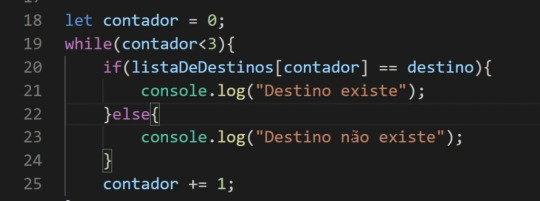
Esses são os BreakPoints:
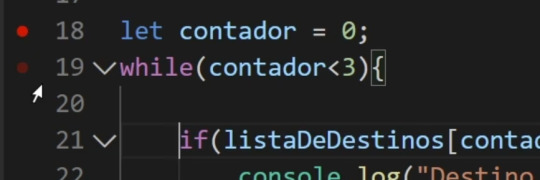
Assim, quando for Debbugar, o código vai parar nesses pontos

Assim você consegue verificar exatamente o que está acontecendo com o isso código, ou é claro, você pode ser RAIZ e meter uma série de console.log() e ver o que está acontecendo.
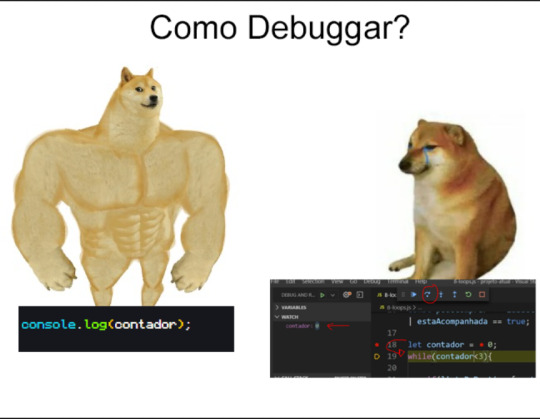
Meu último tópico sobre o JavaScript Básico o que eu tenho a comentar é que eu prefiro muito mais a estrutura do While do que do FOR, apesar de serem semelhantes existe uma mudança clara na estrutura do código.
Enquanto no While você insere a condição dentro do parênteses, no FOR você precisa colocar o valor da variável, sua condição e o que deve ser executado, tudo logo de cara e sem choro.
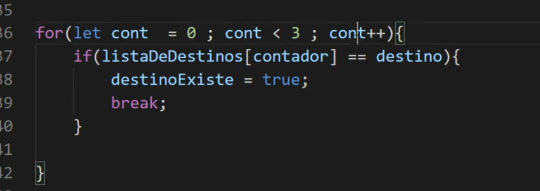
Enfim pessoal, eu dei uma geral simples sobre o JavaScript básico e tenho muito mais a comentar sobre a Programação Orientada a Objetos do JavaScript, se quiserem que eu faça uma parte 2 desse comentário basta pedir e se quiserem podem acompanhar o desenrolar dessa saga lá no Youtube: FaaF Archive!
https://www.youtube.com/@faafarchive
#youtube#coding#programação#python#html css#htmlcoding#80s#nostalgia#vintage#jujutsu kaisen#javascript
0 notes
Text
Why is typescript being so annoying. I just want to be able to pass an item or array of items into the function. Why do you have to be so pissy about types. Why can't I just say "if it is an array, do this". I can't even ask it "is this an array". I hate it.
0 notes
Text
Matt Pocock's Total TypeScript: Essentials
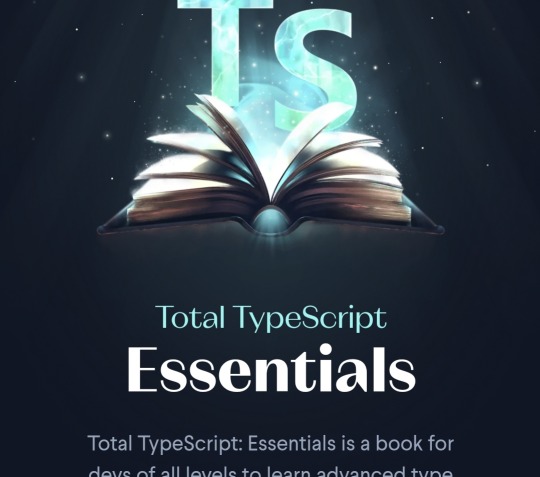
Some notes I made while reading this book:
Optional values in a tuple
Not only can a tuple have named values, it can have optional ones:
[name: string, year: number, info?: string]
[string, number, string?]
Dealing with an unknown
If we have obj of type unknown, and we want to get obj.prop of type string, this is how to do it correctly:
typeof obj === 'object' && obj && 'prop' in obj && typeof obj.prop === 'string'
If we refactor the expression above into a return value of a type guard, this would be its type signature:
(obj: unknown) => obj is {prop: string}
Destructuring values of union types (tuples vs. objects)
const [status, value]: ['success', User[]] | ['error', string] = await fetchData();
TS can then guess based on the type of the discriminant (the status variable) the type of the rest of the return value (the value variable), but wouldn't be able to do the same, if fetchData returned an object instead of tuple. An object type should be narrowed first, before we can destructure its value!
Dynamic keys
If we don't know, what keys the object may have during the lifetime of the program, we can have index signatures...
type DynamicKeys = { [index: string]: number; }
interface DynamicKeys { [index: string]: string; }
...or we can use Record helper type. Record type supports union types of type literals, unlike index signatures!
type DynamicKeys = Record<'name' | 'age' | 'occupation', boolean>
Read-only arrays
We can disallow array mutation by marking arrays and tuples as readonly, or using ReadonlyArray helper type:
const readOnlyGenres: readonly string[] = ["rock", "pop", "unclassifiable"];
const readOnlyGenres: ReadonlyArray<string> = ["rock", "pop", "unclassifiable"];
Read-only arrays/tuples can only be passed to functions that explicitly expect read-only arrays/tuples:
Matt's strange opinions on class methods
function printGenresReadOnly(genres: readonly string[]) { }
More helper types
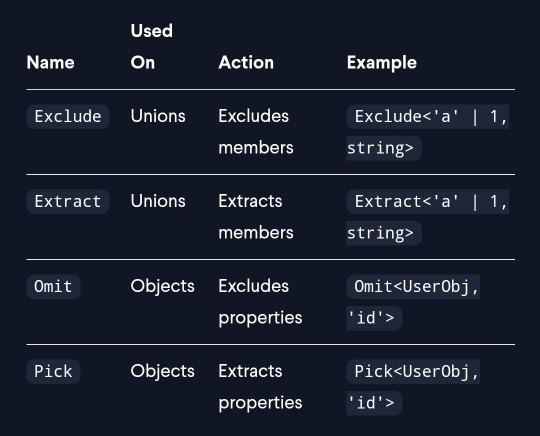
When Matt talks about the difference between arrow and function methods, he mentions only the different ways they handle this, but isn't a much more important distinction the fact that arrow methods are technically class properties, so will be copied on every instance of a class?
UPD: And later he recommends using arrow functions!

This is extremely memory inefficient, right?
satisfies operator
Very useful thing I've never heard of before!
When a value isn't annotated with type, its type is inferred. When a value is annotated with type, its type is checked against the annotated type. When a value is followed with satisfies, its type is inferred (as if there were no annotation), but still checked against the constraint (as if there were an annotation).
Useful (?) type assertions
as any // turns off type checking for a particular value.
as unknown as T // cast a value to a completely unrelated type.
as const satisfies T // makes a value immutable, while checking it against a type.
Object.keys (user).forEach((key) => { console.log(user[key as keyof typeof user]); }) // by default TS infers return values of Object.keys() and for ... in as string[].
Excess properties
TS doesn't throw an error, when (1) a variable containing an object with excess properties is passed to a function, or (2) when an object with excess properties is returned by a callback. Both the variable and the return type of the callback should be annotated, if that is an issue.
Modules vs. scripts
Files with no import or export statement are treated by the compiler as scripts, executing in the global scope. The problem is, that's not how the distinction works in pure JS, so we can end up in sitiations like this...
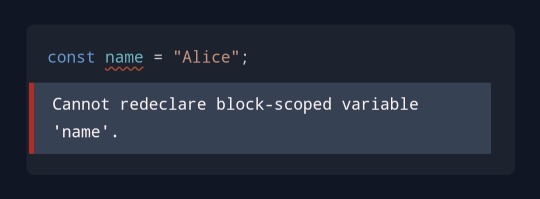
...just because the name variable already exists elsewhere. One way to fix this mistake (which I knew about) is by adding export {}; to the end of the file, turning it into a module from TS perspective. Another way (which I found out about just now) is by adding line "moduleDetection": "force" to the config file. Cool.
Recommended configuration (link)
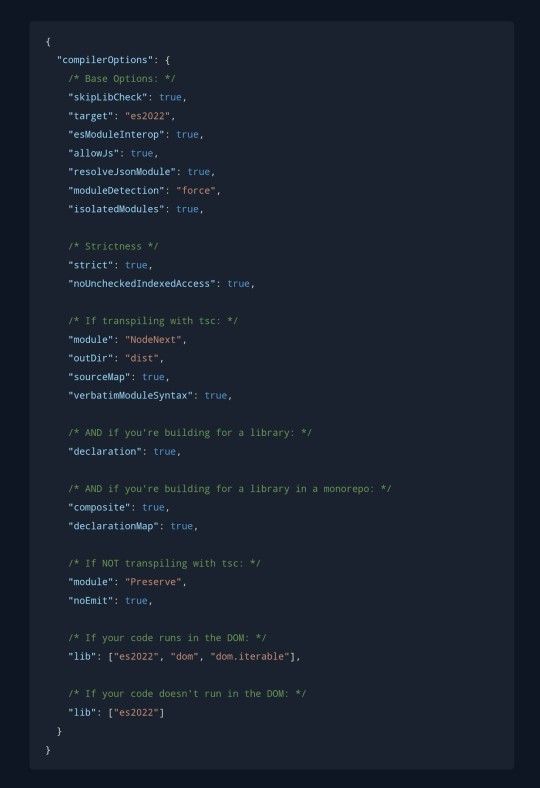
0 notes